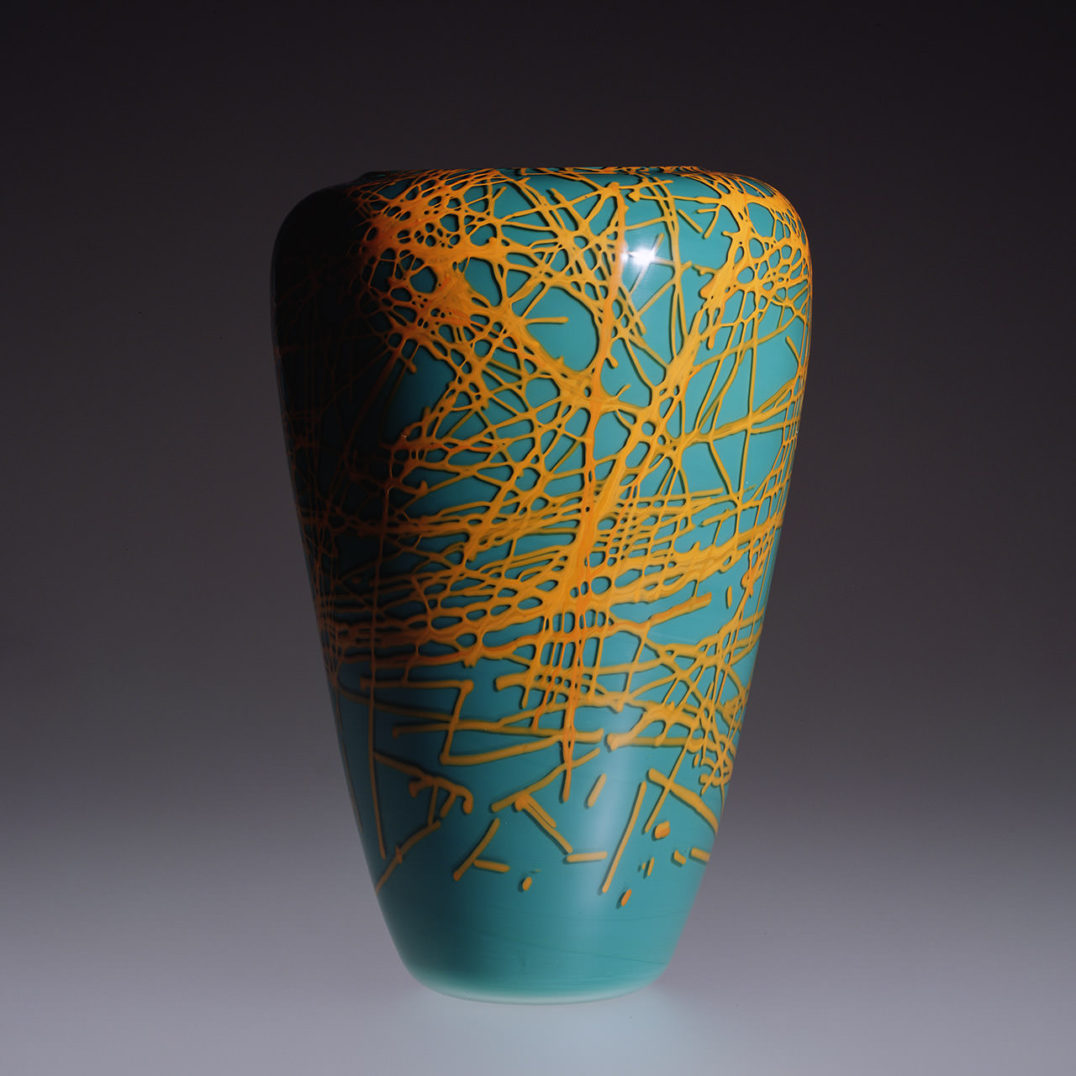
Mary Ann ZynskyFolto, 1984
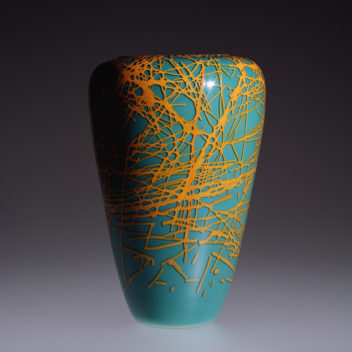
Mary Ann ZynskyFoltoVenini & C., 1984
A green vase decorated with a random design of orange threads.
Engraved: Zinsky x Venini 1984.
12 1/2 in. high (31.5 cm)
Bibliography and comparative texts:
R. Linzeler, 1922, p. 666;
C. Carrà, 1923, p. 67;
R. Linzeler, 1923, p. 83;
R. Papini, 1930, n. 570;
G. Mariacher, 1967, p. 98;
R. Barovier Mentasti, 1982, n. 252;
Mille anni…, 1982, n. 503;
F. Deboni, 1984, p. n. 70;
W. Neuwirth, 1987, nn. 7, 104;
A. Dorigato, 1986, p. 71;
F. Deboni, 1989, n. 1;
L’arte del vetro, 1982, n. 307;
M. Heiremans, 1993, n. 191;
M. Barovier, R. Barovier Mentasti,
A. Dorigato, 1995, n. 15;
A. Venini Diaz de Santillana, 1996, n. 1;
R. Barovier Mentasti, 1998, n. 25;
A. Venini Diaz de Santillana, 2000, n. 1;
Olnick Spanu, 2000, n. 8;
Olnick Spanu, 2001, n. 13.
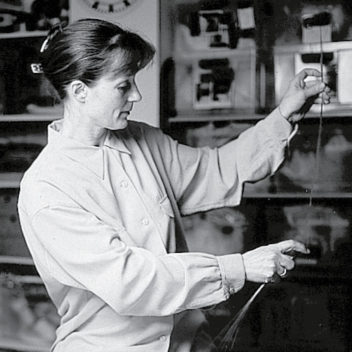
Mary Ann Zynsky 1951–
Designer Mary Ann "Toots" Zynsky was born in Boston and attended the Rhode Island School of Design, the Pilchuck Glass School, and the Craft School at Haystack, taking part in various experiences and experiments. From 1981 to 1983, she collaborated with Venini, where, with the help of maestro Checco Ongaro, she created a remarkable series of pieces. Among these are the vessels called Folto, whose openings have wide turned-over lips, and decorations with glass rods produced out of hair-thin threads made with a technique she invented herself. Her works are present not only in the major international museums, but also in the White House amidst the works of the best American artists.

Venini & C. 1932–2001
In 1932, when both Martinuzzi and Zecchin left the company, Paolo Venini changed the name from Vetri Soffiati Muranesi Venini & Co. (V.S.M. Venini & Co.) to Venini & C.. Milanese architect Tommaso Buzzi became the new artistic director. After 1934, artistic direction was taken on by Carlo Scarpa, who designed most of the company's production through 1947. Side by side with Venini, who often intervened personally in design, Scarpa created numerous collections of objects characterized by refined colors. After World War II, Venini & C. sought numerous collaborations with artists such as architect Giò Ponti and the Swedish-born Tyra Lundgren. After 1948, Fulvio Bianconi, Massimo Vignelli, and Tobia Scarpa contributed significantly to the new direction of the company. Paolo Venini died in 1959 and his son-in-law, Ludovico Diaz de Santillana, took over the management of Venini & C. He not only worked personally as a glass designer but also continued the collaboration started by Paolo Venini with various artists and designers. Starting in 1960, many other designers collaborated with the company, like Thomas Stearns, Toni Zuccheri, Tapio Wirkkala, Laura and Alessandro Diaz de Santillana, James Carpenter, Dan Dailey, Richard Marquis, Benjamin Moore, and Toots Zynsky. In 1986, the de Santillana family left the company, selling their stock to the Ferruzzi group, which guaranteed the fine quality Venini was known for by hiring new designers such as Timo Sarpaneva, Marco Zanini, Ettore Sottsass Jr., Alessandro Mendini, Mario Bellini, Barbara del Vicario, and others. In 1988, Venini was acquired by Royal Scandinavian. Since 2001, Venini S.p.A. has been part of Italian Luxury Industries Group and is led by Giancarlo Chimento, Giuliano Tabacchi, and Giorgio Rizzo.
Mary Ann ZynskyFolto, 1984
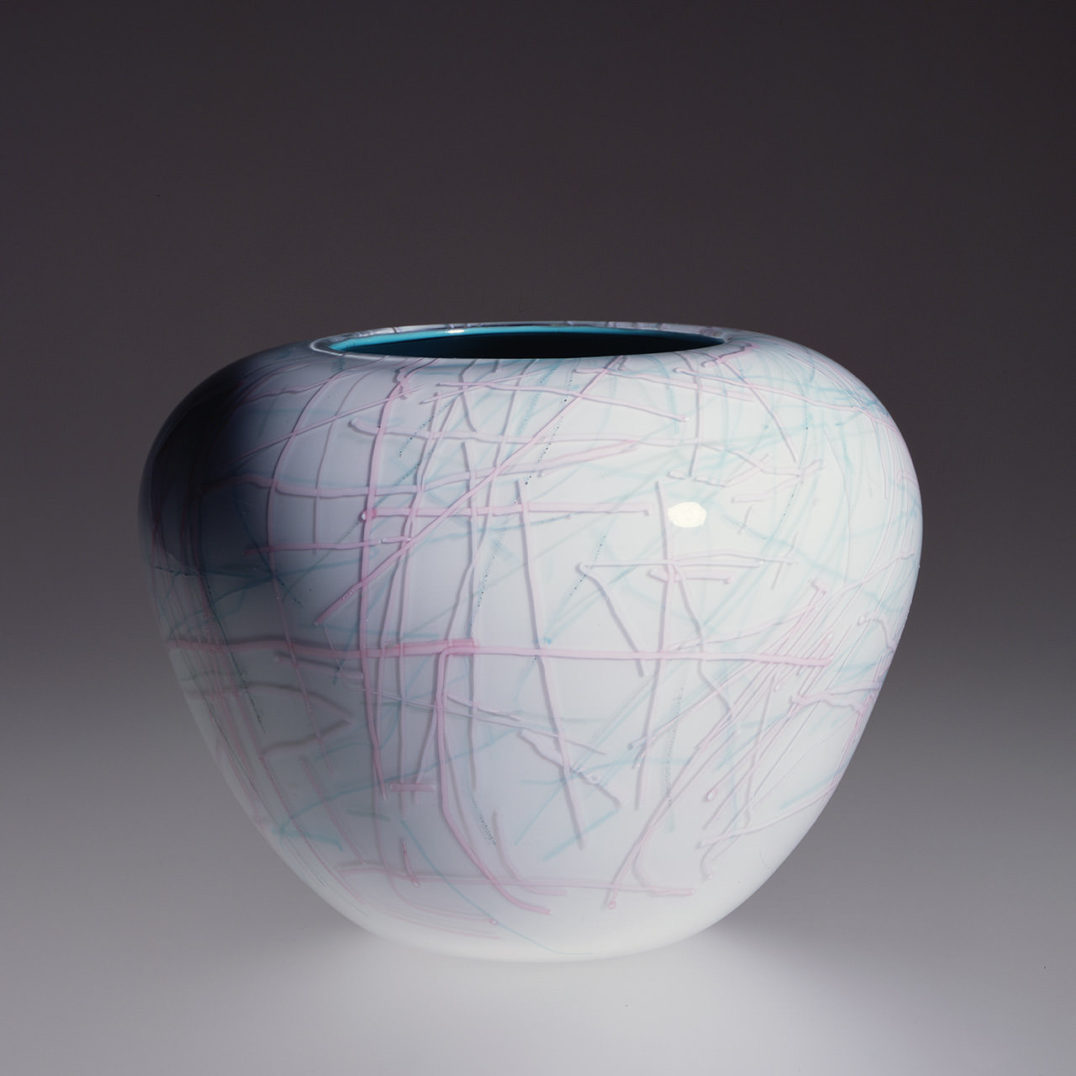
Mary Ann ZynskyFolto, 1984
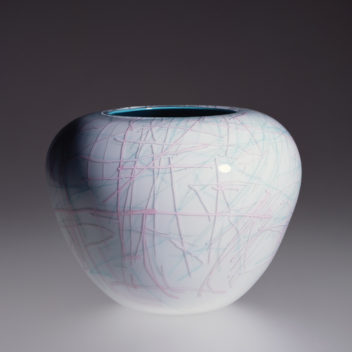
Mary Ann ZynskyFoltoVenini & C., 1984
A turquoise bowl cased inlattimo glass decorated with a random design of pink and pale blue threads.
Engraved: Zinsky x Venini 1984.
7 1/4 in. high (18.5 cm)
Bibliography and comparative texts:
R. Linzeler, 1922, p. 666;
C. Carrà, 1923, p. 67;
R. Linzeler, 1923, p. 83;
R. Papini, 1930, n. 570;
G. Mariacher, 1967, p. 98;
R. Barovier Mentasti, 1982, n. 252;
Mille anni…, 1982, n. 503;
F. Deboni, 1984, p. n. 70;
W. Neuwirth, 1987, nn. 7, 104;
A. Dorigato, 1986, p. 71;
F. Deboni, 1989, n. 1;
L’arte del vetro, 1982, n. 307;
M. Heiremans, 1993, n. 191;
M. Barovier, R. Barovier Mentasti,
A. Dorigato, 1995, n. 15;
A. Venini Diaz de Santillana, 1996, n. 1;
R. Barovier Mentasti, 1998, n. 25;
A. Venini Diaz de Santillana, 2000, n. 1;
Olnick Spanu, 2000, n. 8;
Olnick Spanu, 2001, n. 13.

Mary Ann Zynsky 1951–
Designer Mary Ann "Toots" Zynsky was born in Boston and attended the Rhode Island School of Design, the Pilchuck Glass School, and the Craft School at Haystack, taking part in various experiences and experiments. From 1981 to 1983, she collaborated with Venini, where, with the help of maestro Checco Ongaro, she created a remarkable series of pieces. Among these are the vessels called Folto, whose openings have wide turned-over lips, and decorations with glass rods produced out of hair-thin threads made with a technique she invented herself. Her works are present not only in the major international museums, but also in the White House amidst the works of the best American artists.

Venini & C. 1932–2001
In 1932, when both Martinuzzi and Zecchin left the company, Paolo Venini changed the name from Vetri Soffiati Muranesi Venini & Co. (V.S.M. Venini & Co.) to Venini & C.. Milanese architect Tommaso Buzzi became the new artistic director. After 1934, artistic direction was taken on by Carlo Scarpa, who designed most of the company's production through 1947. Side by side with Venini, who often intervened personally in design, Scarpa created numerous collections of objects characterized by refined colors. After World War II, Venini & C. sought numerous collaborations with artists such as architect Giò Ponti and the Swedish-born Tyra Lundgren. After 1948, Fulvio Bianconi, Massimo Vignelli, and Tobia Scarpa contributed significantly to the new direction of the company. Paolo Venini died in 1959 and his son-in-law, Ludovico Diaz de Santillana, took over the management of Venini & C. He not only worked personally as a glass designer but also continued the collaboration started by Paolo Venini with various artists and designers. Starting in 1960, many other designers collaborated with the company, like Thomas Stearns, Toni Zuccheri, Tapio Wirkkala, Laura and Alessandro Diaz de Santillana, James Carpenter, Dan Dailey, Richard Marquis, Benjamin Moore, and Toots Zynsky. In 1986, the de Santillana family left the company, selling their stock to the Ferruzzi group, which guaranteed the fine quality Venini was known for by hiring new designers such as Timo Sarpaneva, Marco Zanini, Ettore Sottsass Jr., Alessandro Mendini, Mario Bellini, Barbara del Vicario, and others. In 1988, Venini was acquired by Royal Scandinavian. Since 2001, Venini S.p.A. has been part of Italian Luxury Industries Group and is led by Giancarlo Chimento, Giuliano Tabacchi, and Giorgio Rizzo.
Mary Ann ZynskyFolto, 1984
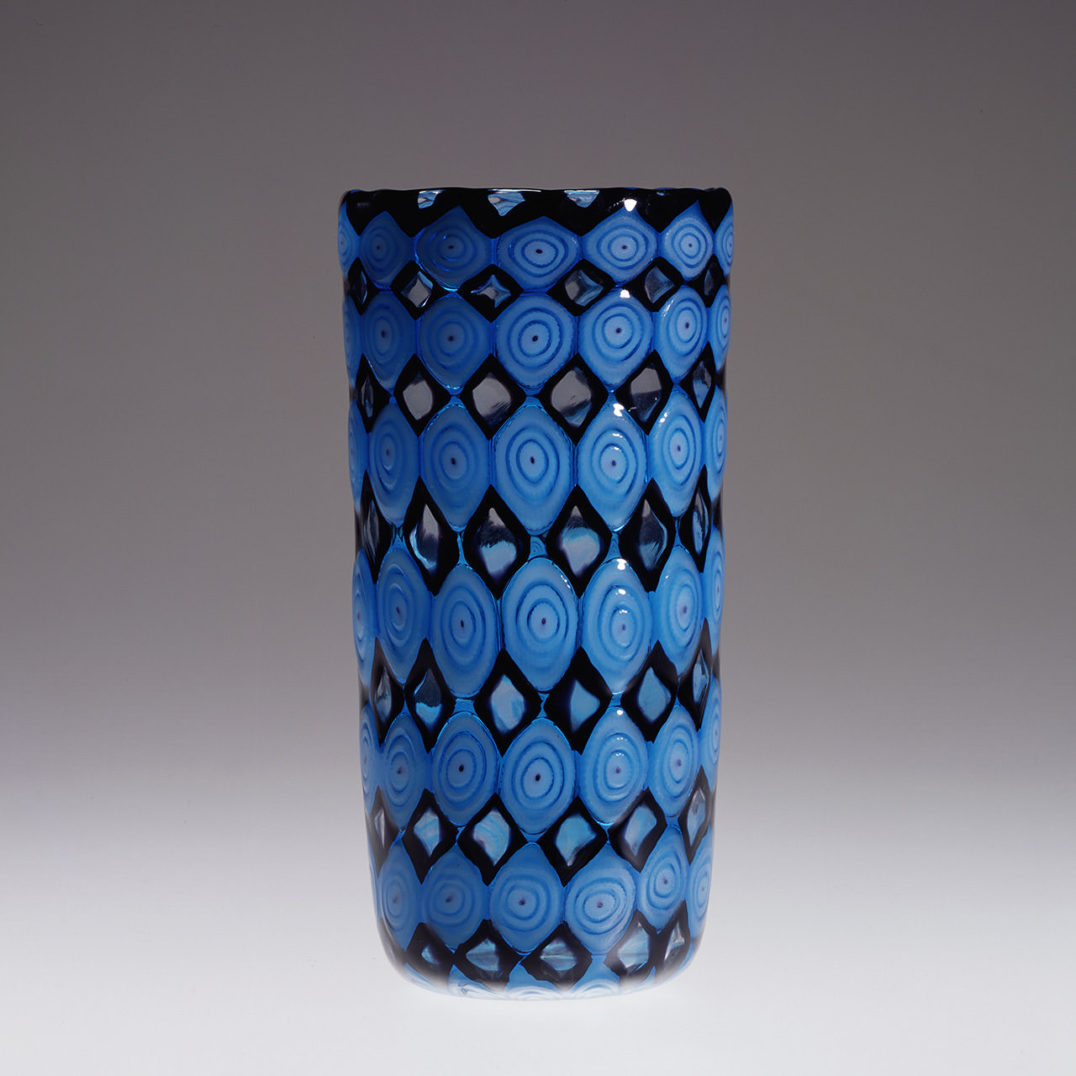
Ermanno TosoCaccia, 1984
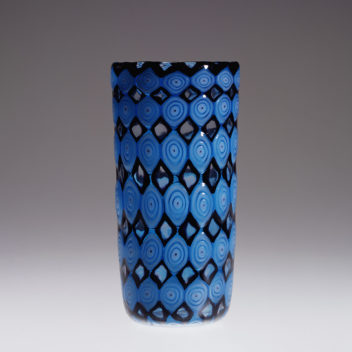
Ermanno TosoCacciaBarovier & Toso, 1984
Cylindrical vase composed of two alternating glass bands. One band is made of circular cristallo, lattimoand blue tessere, the other is Diamond-shaped cristalloand black tessere.
9 in. high (23 cm)
Bibliography and comparative texts:
R. Linzeler, 1922, p. 666;
C. Carrà, 1923, p. 67;
R. Linzeler, 1923, p. 83;
R. Papini, 1930, n. 570;
G. Mariacher, 1967, p. 98;
R. Barovier Mentasti, 1982, n. 252;
Mille anni…, 1982, n. 503;
F. Deboni, 1984, p. n. 70;
W. Neuwirth, 1987, nn. 7, 104;
A. Dorigato, 1986, p. 71;
F. Deboni, 1989, n. 1;
L’arte del vetro, 1982, n. 307;
M. Heiremans, 1993, n. 191;
M. Barovier, R. Barovier Mentasti,
A. Dorigato, 1995, n. 15;
A. Venini Diaz de Santillana, 1996, n. 1;
R. Barovier Mentasti, 1998, n. 25;
A. Venini Diaz de Santillana, 2000, n. 1;
Olnick Spanu, 2000, n. 8;
Olnick Spanu, 2001, n. 13.
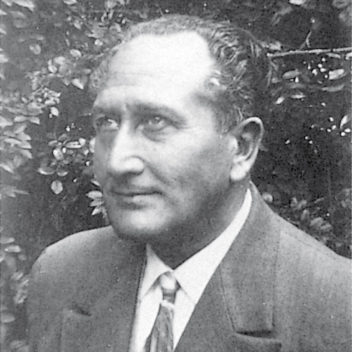
Ermanno Toso 1903–1973
Born on Murano, Ermanno Toso began to work at the Fratelli Toso workshop in 1924, where he was later to become a partner. In 1936, he was named artistic and marketing director of the company. During the period preceding World War II, he created thick glass pieces using traditional decorative techniques that were characterized by simple and solid shapes inspired by the Novecento style. During the '50s, he created a collection of extraordinarily lightweight glass pieces based on a modern interpretation of classical techniques, such as filigrana and murrina. During the '60s, his creative talent led him towards an absolute multicolored sobriety.
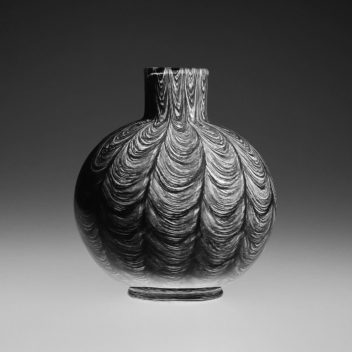
Barovier & Toso 1942–
In 1936, Ercole Barovier became partner of the S.A.I.A.R. Ferro Toso, forming Ferro Toso e Barovier. In 1939, it became Barovier Toso & C., and finally, in 1942, its name was changed to Barovier & Toso. Ercole Barovier remained artistic director of the company through 1972 and was succeeded by his son, Angelo, who was already a designer for the company. Beginning in the '80s and continuing through today, many have designers collaborated with Barovier & Toso. Among them are Matteo Thun, Toni Zuccheri, Renato and Giusto Toso, and Noti Massari. The company’s most recent productions have been created by designers like Roberto Caddeo, Marco Mencacci, Franco Raggi, Luca Scacchetti, and others. Barovier & Toso is currently directed by Angelo, his son Jacopo, and Giovanni Toso.
Ermanno TosoCaccia, 1984
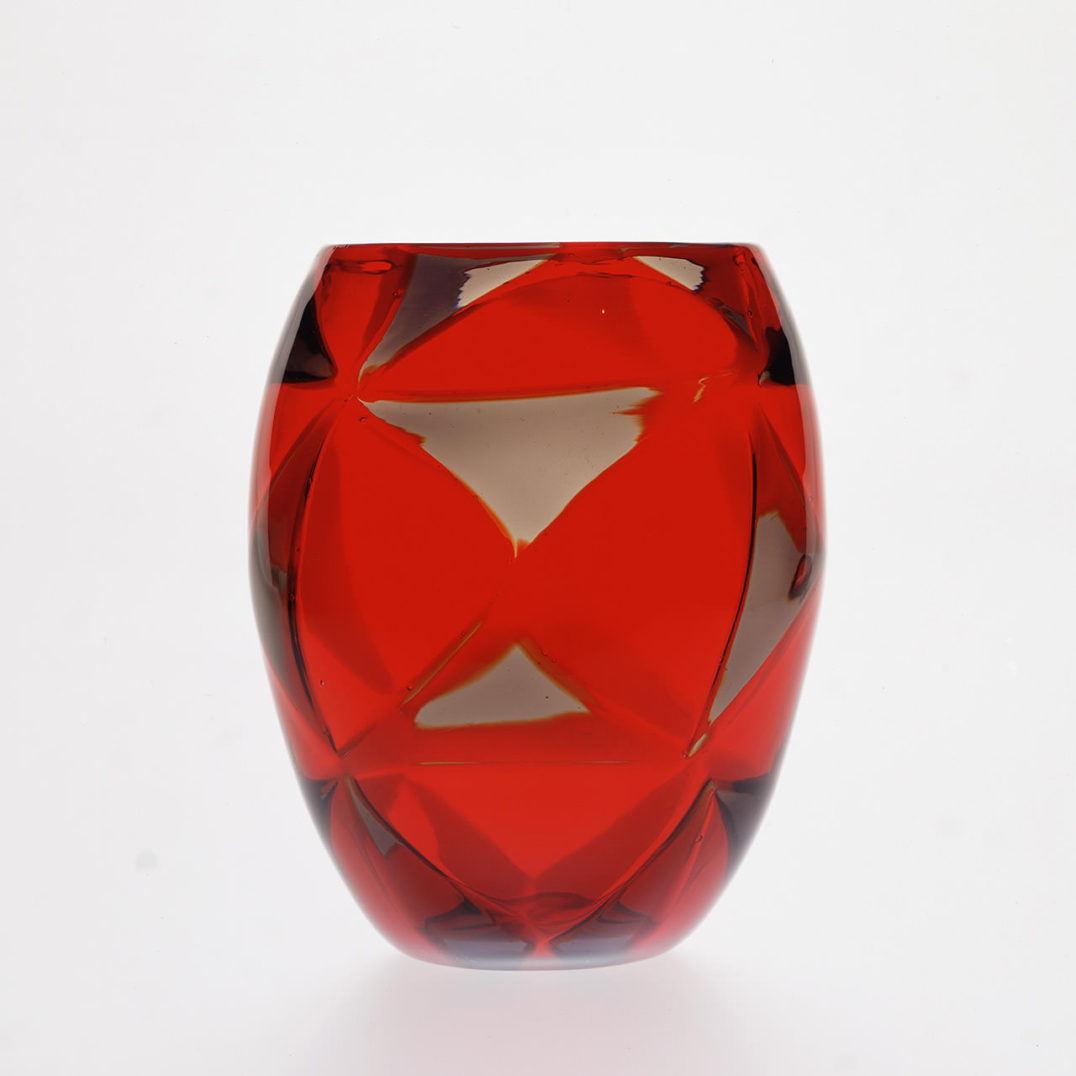
Ermanno TosoIntarsio, 1961–1963
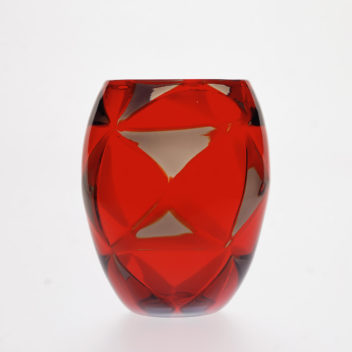
Ermanno TosoIntarsioBarovier & Toso, 1961–1963
Vase composed of grey and red triangular shaped transparent glass patchessommersi in cristallo.
12 in. high (30 cm)
Bibliography and comparative texts:
R. Linzeler, 1922, p. 666;
C. Carrà, 1923, p. 67;
R. Linzeler, 1923, p. 83;
R. Papini, 1930, n. 570;
G. Mariacher, 1967, p. 98;
R. Barovier Mentasti, 1982, n. 252;
Mille anni…, 1982, n. 503;
F. Deboni, 1984, p. n. 70;
W. Neuwirth, 1987, nn. 7, 104;
A. Dorigato, 1986, p. 71;
F. Deboni, 1989, n. 1;
L’arte del vetro, 1982, n. 307;
M. Heiremans, 1993, n. 191;
M. Barovier, R. Barovier Mentasti,
A. Dorigato, 1995, n. 15;
A. Venini Diaz de Santillana, 1996, n. 1;
R. Barovier Mentasti, 1998, n. 25;
A. Venini Diaz de Santillana, 2000, n. 1;
Olnick Spanu, 2000, n. 8;
Olnick Spanu, 2001, n. 13.

Ermanno Toso 1903–1973
Born on Murano, Ermanno Toso began to work at the Fratelli Toso workshop in 1924, where he was later to become a partner. In 1936, he was named artistic and marketing director of the company. During the period preceding World War II, he created thick glass pieces using traditional decorative techniques that were characterized by simple and solid shapes inspired by the Novecento style. During the '50s, he created a collection of extraordinarily lightweight glass pieces based on a modern interpretation of classical techniques, such as filigrana and murrina. During the '60s, his creative talent led him towards an absolute multicolored sobriety.

Barovier & Toso 1942–
In 1936, Ercole Barovier became partner of the S.A.I.A.R. Ferro Toso, forming Ferro Toso e Barovier. In 1939, it became Barovier Toso & C., and finally, in 1942, its name was changed to Barovier & Toso. Ercole Barovier remained artistic director of the company through 1972 and was succeeded by his son, Angelo, who was already a designer for the company. Beginning in the '80s and continuing through today, many have designers collaborated with Barovier & Toso. Among them are Matteo Thun, Toni Zuccheri, Renato and Giusto Toso, and Noti Massari. The company’s most recent productions have been created by designers like Roberto Caddeo, Marco Mencacci, Franco Raggi, Luca Scacchetti, and others. Barovier & Toso is currently directed by Angelo, his son Jacopo, and Giovanni Toso.
Ermanno TosoIntarsio, 1961–1963
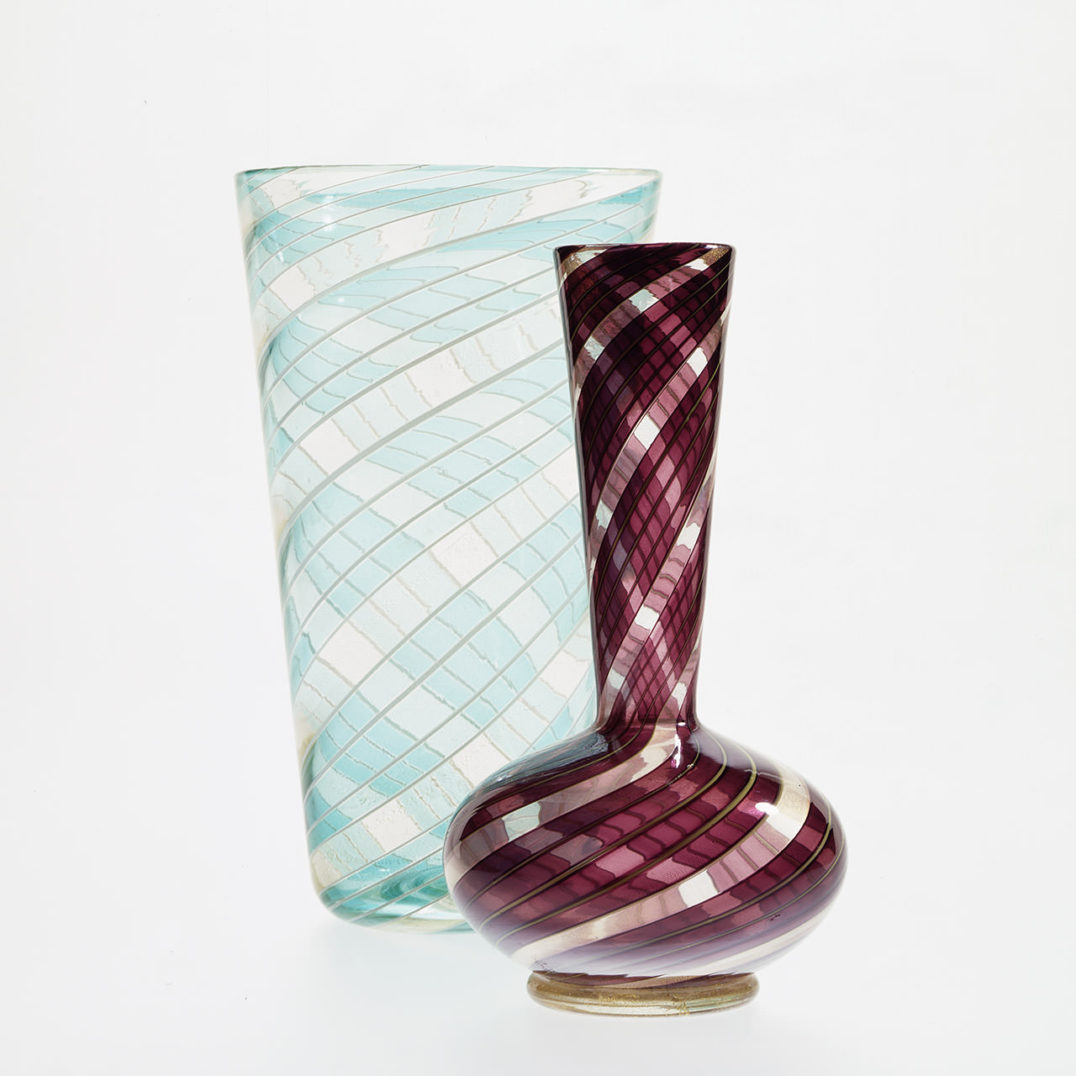
Ermanno TosoNeolitico, 1954
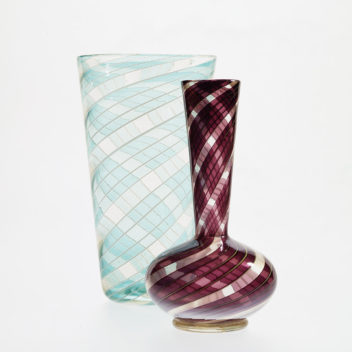
Ermanno TosoNeoliticoBarovier & Toso, 1954
Two tall glass vessels. The vessel on the left is composed of intersectingcristallo and aquamarine canes; the vessel on the right is composed of intersecting cristallo and amethyst canes.
16 in. high (41 cm)
14 in. high (36 cm)
Bibliography and comparative texts:
R. Linzeler, 1922, p. 666;
C. Carrà, 1923, p. 67;
R. Linzeler, 1923, p. 83;
R. Papini, 1930, n. 570;
G. Mariacher, 1967, p. 98;
R. Barovier Mentasti, 1982, n. 252;
Mille anni…, 1982, n. 503;
F. Deboni, 1984, p. n. 70;
W. Neuwirth, 1987, nn. 7, 104;
A. Dorigato, 1986, p. 71;
F. Deboni, 1989, n. 1;
L’arte del vetro, 1982, n. 307;
M. Heiremans, 1993, n. 191;
M. Barovier, R. Barovier Mentasti,
A. Dorigato, 1995, n. 15;
A. Venini Diaz de Santillana, 1996, n. 1;
R. Barovier Mentasti, 1998, n. 25;
A. Venini Diaz de Santillana, 2000, n. 1;
Olnick Spanu, 2000, n. 8;
Olnick Spanu, 2001, n. 13.

Ermanno Toso 1903–1973
Born on Murano, Ermanno Toso began to work at the Fratelli Toso workshop in 1924, where he was later to become a partner. In 1936, he was named artistic and marketing director of the company. During the period preceding World War II, he created thick glass pieces using traditional decorative techniques that were characterized by simple and solid shapes inspired by the Novecento style. During the '50s, he created a collection of extraordinarily lightweight glass pieces based on a modern interpretation of classical techniques, such as filigrana and murrina. During the '60s, his creative talent led him towards an absolute multicolored sobriety.

Barovier & Toso 1942–
In 1936, Ercole Barovier became partner of the S.A.I.A.R. Ferro Toso, forming Ferro Toso e Barovier. In 1939, it became Barovier Toso & C., and finally, in 1942, its name was changed to Barovier & Toso. Ercole Barovier remained artistic director of the company through 1972 and was succeeded by his son, Angelo, who was already a designer for the company. Beginning in the '80s and continuing through today, many have designers collaborated with Barovier & Toso. Among them are Matteo Thun, Toni Zuccheri, Renato and Giusto Toso, and Noti Massari. The company’s most recent productions have been created by designers like Roberto Caddeo, Marco Mencacci, Franco Raggi, Luca Scacchetti, and others. Barovier & Toso is currently directed by Angelo, his son Jacopo, and Giovanni Toso.